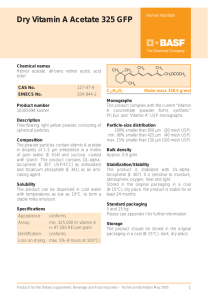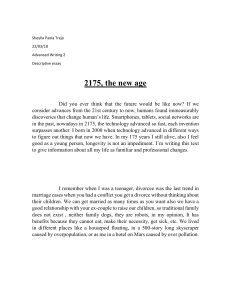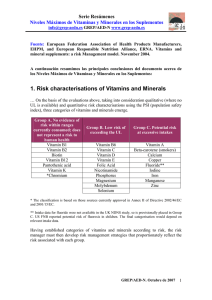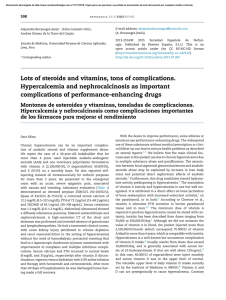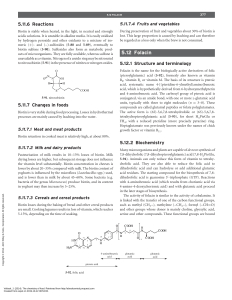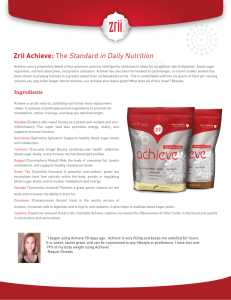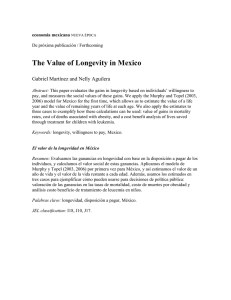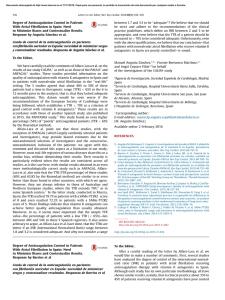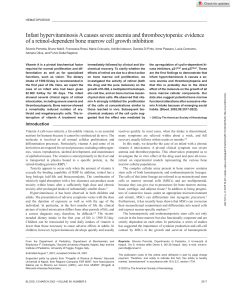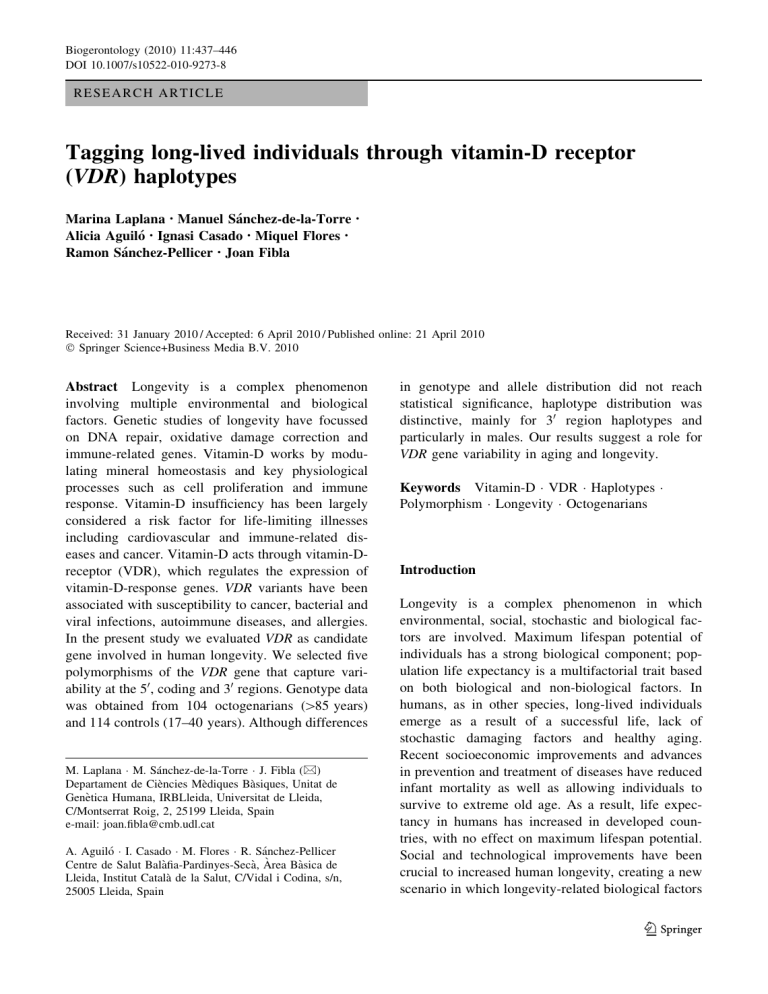
Biogerontology (2010) 11:437–446 DOI 10.1007/s10522-010-9273-8 RESEARCH ARTICLE Tagging long-lived individuals through vitamin-D receptor (VDR) haplotypes Marina Laplana • Manuel Sánchez-de-la-Torre Alicia Aguiló • Ignasi Casado • Miquel Flores • Ramon Sánchez-Pellicer • Joan Fibla • Received: 31 January 2010 / Accepted: 6 April 2010 / Published online: 21 April 2010 ! Springer Science+Business Media B.V. 2010 Abstract Longevity is a complex phenomenon involving multiple environmental and biological factors. Genetic studies of longevity have focussed on DNA repair, oxidative damage correction and immune-related genes. Vitamin-D works by modulating mineral homeostasis and key physiological processes such as cell proliferation and immune response. Vitamin-D insufficiency has been largely considered a risk factor for life-limiting illnesses including cardiovascular and immune-related diseases and cancer. Vitamin-D acts through vitamin-Dreceptor (VDR), which regulates the expression of vitamin-D-response genes. VDR variants have been associated with susceptibility to cancer, bacterial and viral infections, autoimmune diseases, and allergies. In the present study we evaluated VDR as candidate gene involved in human longevity. We selected five polymorphisms of the VDR gene that capture variability at the 50 , coding and 30 regions. Genotype data was obtained from 104 octogenarians ([85 years) and 114 controls (17–40 years). Although differences M. Laplana ! M. Sánchez-de-la-Torre ! J. Fibla (&) Departament de Ciències Mèdiques Bàsiques, Unitat de Genètica Humana, IRBLleida, Universitat de Lleida, C/Montserrat Roig, 2, 25199 Lleida, Spain e-mail: [email protected] A. Aguiló ! I. Casado ! M. Flores ! R. Sánchez-Pellicer Centre de Salut Balàfia-Pardinyes-Secà, Àrea Bàsica de Lleida, Institut Català de la Salut, C/Vidal i Codina, s/n, 25005 Lleida, Spain in genotype and allele distribution did not reach statistical significance, haplotype distribution was distinctive, mainly for 30 region haplotypes and particularly in males. Our results suggest a role for VDR gene variability in aging and longevity. Keywords Vitamin-D ! VDR ! Haplotypes ! Polymorphism ! Longevity ! Octogenarians Introduction Longevity is a complex phenomenon in which environmental, social, stochastic and biological factors are involved. Maximum lifespan potential of individuals has a strong biological component; population life expectancy is a multifactorial trait based on both biological and non-biological factors. In humans, as in other species, long-lived individuals emerge as a result of a successful life, lack of stochastic damaging factors and healthy aging. Recent socioeconomic improvements and advances in prevention and treatment of diseases have reduced infant mortality as well as allowing individuals to survive to extreme old age. As a result, life expectancy in humans has increased in developed countries, with no effect on maximum lifespan potential. Social and technological improvements have been crucial to increased human longevity, creating a new scenario in which longevity-related biological factors 123 438 have been able to operate. The aging process has been considered the result of the accumulation of damages in cells and tissues that, left uncorrected, produces a systemic dysfunction concluding in death. Throughout the lifespan, however, cell maintenance mechanisms, such as DNA-repairing enzymes, correction of oxidative damage and immune system response against pathogens and tumour cells, attempt to correct the damage. Among environmental factors acting on health status, vitamin-D has been largely considered protective and a promoter of good health (Holick and Chen 2008). Pleiotropic effects of vitamin-D have been largely known to affect mineral metabolism, cell proliferation and immune response modulation. Vitamin-D status has been described as involved in lifelimiting diseases (Heaney 2008) such as cancer (Garland et al. 2009), cardiovascular diseases (Gouni-Berthold et al. 2009), osteoporosis (Lash et al. 2009), sarcopenia (Roth et al. 2004; Visser et al. 2003) and diabetes (Danescu et al. 2009). In addition, vitamin-D has an important role in the modulation of the immune response, inducing microbicide factors against bacterial infections (Wang et al. 2004) and controlling the exacerbation of the cellular immune response (Deluca and Cantorna 2001). Based on this, it has been proposed a major positive role for vitamin-D in biogerontology by reducing susceptibility in the elderly to chronic degenerative diseases (Hayes 2010). Sources of vitamin-D come from dietary intake, mainly oily fish such as salmon, mackerel and sardines (Chen et al. 2007) and egg yolks (LambergAllardt 2006), and from endogenous synthesis by photolytic reaction of vitamin-D precursors in the skin (Lips 2006). Both types of sources are strongly linked to environment, such as climate and latitude, and social behaviour, such as daily diet, sun exposure and clothing. In addition, demographic factors must be considered, such as culture habits, gender and age, which act in several ways to change social behaviour as well as race, which is related to melanin pigmentation (Chen et al. 2007). Genes coding for vitamin-D metabolic enzymes and downstream mediators of vitamin-D signalling constitute a complex gene network. Vitamin-D receptor (VDR) plays a pivotal role in this network, acting as a ligand-dependent transcription factor that modulates the expression of vitamin-D responsive genes (Pike 1991). 123 Biogerontology (2010) 11:437–446 Several VDR polymorphisms with functional effects have been described in the promoter, coding and 30 untranslated region (UTR) (Uitterlinden et al. 2004a). Two common polymorphisms, Cdx (rs1568820) and A1012G (rs4516035), have been located in the 50 regulatory region that affect binding to transcription factors. The rs1568820 polymorphism is a G to A transition between exons 1f and 1e that alters the recognition site for the intestinal-specific transcription factor ‘‘caudal-related homeodomain protein-2’’ (Cdx2), affecting vitamin-D-VDR-mediated intestinal calcium absorption (Arai et al. 2001). The rs4516035 polymorphism is an A to G transition located between 1e and 1a exons that modifies the GATA-3 transcription factor recognition sequence, involved in the regulation of Th2 polarization (Halsall et al. 2004). In addition, a common FokI (rs10735810) polymorphism has been described in the VDR coding region that alters the first ATG start site to an alternate ACG sequence, giving rise to a VDR protein that is three amino acids shorter (424 aas versus 427 aas) (Gross et al. 1996). Functional differences among rs10735810 genotypes shows that VDR protein coded by the C-VDR allele (short 424 aas) interacted more efficiently with TFIIB and showed greater transcriptional activity than the full-length VDR protein coded by T-VDR allele (Jurutka et al. 2000). Finally, a common restriction fragment length polymorphism (RFLP), designated as BsmI (rs1544410), and a microsatellite polymorphism, designated as PolyA (rs17878969), has been described in the 30 -UTR region (Morrison et al. 1994; Ingles et al. 1997). Functional effects of 30 -UTR variants have been related to alterations in VDR mRNA stability (Fang et al. 2005). Knowledge of the genomic architecture is important for designing association studies of complex phenotypes, as revealed by recent research on the linkage disequilibrium (LD) pattern of the human genome. LD refers to the non-random transmission of alleles of neighbouring loci that is high for closer loci and decreases with distance. In addition, recombination rate is a determinant factor for decreasing LD. The underlying structure of LD in the human genome reveals a series of discrete blocks of high LD interrupted by hotspot recombination sites. LD blocks range from 5 to 50 kb and are characterized by a reduced diversity of allelic combinations (haplotypes) (Wall and Pritchard 2003). Studies of the VDR genomic region in Caucasians have revealed a Biogerontology (2010) 11:437–446 scattered LD pattern with rs1568820 and rs4516035 polymorphisms included in a single block of the VDR promoter and rs1544410 and rs17878969 polymorphisms included in a 30 UTR block. Blocks are separated by a hotspot recombination region that includes the rs10735810 polymorphism (Fang et al. 2005). Several studies reveal that polymorphisms at VDR locus are associated with life-limiting diseases such as cancer, cardiovascular diseases and immune system disturbances (Uitterlinden et al. 2004b). Therefore, we propose VDR as a candidate gene involved in human longevity as a result of its protection from age-related diseases and modulation of the immune response. Taking advantage of the known haplotype block structure of the VDR genomic region, we performed an association study for longevity considering both single genotypes and haplotypes. Materials and methods Subjects In total, 214 Caucasian subjects from the city of Lleida in northeast Spain were included between January and June 2004: 104 octogenarians ([85 years), 72 women (mean age 89.4 ± 3.6; range 85–100) and 32 men (mean age 89.4 ± 3.2; range 85– 97), and 110 sex-matched healthy young individuals, 75 women (mean age 28 ± 5.8; range 17–39) and 35 men (mean age 29 ± 8.6; range 17–40), were selected as cases and controls, respectively. A comprehensive medical history was obtained from each octogenarian, focussing on the absence of vitamin-D related illness such as osteoporosis, autoimmune diseases, immunodeficiency and cancer. Written informed consent for enrolment in the study and for personal data management was obtained from all subjects in accordance with Spanish laws. The Ethics Committee for our institution approved the study. DNA sources and genotyping Genomic DNA from controls was extracted from peripheral blood lymphocytes using a KG-Midi extraction kit (Camgen, Cambridge, UK). DNA from octogenarians was obtained from buccal swabs using the BuccalAmp DNA extraction kit (Epicentre, 439 Madison, USA). VDR genotyping followed protocols described by de la Torre et al. (2008). For each subject we obtained genotype information from five polymorphic variants located in the VDR gene at: 50 promoter region, rs11568820 and rs4516035; coding region, rs10735810 and 30 UTR, rs1544410 and rs17878969 (Fig. 1a). All markers were coded as biallelic, including the rs17878969 microsallite polymorphism that shows a biphasic distribution of short (\18 adenosine repeats, S) and long (C18 adenosine repeats, L) allele populations (Ingles et al. 1997). Statistical analysis We compared genotype and allele distribution between controls and octogenarians by contingency table analysis performed by the OpenEpi web resource (Sullivan et al. 2009). Fisher exact test P values were considered in each comparison. Correction for multiple testing was done applying the SNP spectral decomposition approach, which takes into account the linkage disequilibrium between markers (Nyholt 2004). The significance threshold required to maintain a Type I error rate of 5% was P = 0.036 for twomarker haplotypes and P = 0.011 for five-marker haplotypes. Pair-wise linkage disequilibrium was measured by the normalized D0 coefficient (Lewontin 1988) that was estimated using Haploview 4.2 software (Barrett et al. 2005). Absolute D0 values range from 0 (no disequilibrium), indicating that alleles are randomly distributed and all expected haplotypes are observed, to 1 (complete disequilibrium), indicating a non random distribution of alleles with a less observed haplotypes than expected. We used PHASE 2.1.1 software (Stephens et al. 2001) to perform statistical inference of haplotypes from our sample data. Only data from fully genotyped subjects, 86 octogenarians (25 males) and 101 controls (35 males), were considered. We used the ‘‘out_pair’’ PHASE output file to assign haplotypes for each individual, with their corresponding probability. Haplotype counts were estimated by obtaining the cumulative probability of each haplotype. In brief, for an individual bearing haplotype A with probability 0.3 and haplotype B with probability 0.7, 0.3 and 0.7 were added to the corresponding counts of haplotypes A and B, respectively. Following the same rationale, we estimated the presence of 0, 1 or 2 copies of a specific haplotype in each individual. 123 440 Biogerontology (2010) 11:437–446 Fig. 1 Gene structure of the VDR locus and linkage disequilibrium (LD) pattern of populations analysed. (a) Graphical representation of the VDR gene with the location of polymorphisms selected. Polymorphisms are named according to rs code and alias. Small open arrows indicate alternative VDR promoters that incorporate alternative exon 1 (1a–1f). Grey boxes correspond to untranslated exons, empty boxes to coding exons. UTR untranslated region. All markers were coded as biallelic including the rs17878969 microsallite polymorphism that shows a biphasic distribution of short (\18 adenosine repeats, S) and long (C18 adenosine repeats, L) allele populations (Ingles et al. 1997). (b) Graphical representation of the LD pattern in Controls and Octogenarians. D0 values were calculated and plotted by Haploview 4.2 software (http:// www.broad.mit.edu/mpg/haploview). Numbers inside boxes correspond to D0 9100. Block structure was considered for marker pairs showing D0 [ 0.8, following the ‘‘solid-spine’’ block definition implemented in Haploview. In controls, two blocks were identified, block-1 at the 50 regulatory region including markers rs4516035–rs11568820 and block-2 at the 30 UTR region including markers rs17878969–rs1544410. No block pattern was observed in octogenarians Comparison of global haplotype distribution between controls and octogenarians was done by the ‘‘product of approximate conditionals’’ (PAC)-likelihood test implemented in PHASE 2.1.1 (Li and Stephens 2003). Differences between groups for specific haplotypes were evaluated by 2 9 2 contingency table analysis performed by the OpenEpi web resource. differences in genotype and allele distribution between octogenarians and controls, considering all subjects, gender between groups and gender within each group (Table 1). No statistical differences were observed for single-marker genotype association modelled as dominant (common allele homozygotes and heterozygotes versus rare allele homozygotes), recessive (rare allele homozygotes versus common allele homozygotes and heterozygotes) and codominant (cross genotype comparison). Allele distribution did not differ in any comparison performed (Table 1). Linkage disequilibrium pattern in the control sample was in accordance with available data for Caucasian populations (Fang et al. 2005) and block Results The genotype and allele distribution conform to Hardy–Weinberg equilibrium for all markers in both the control and octogenarian samples. We evaluated 123 Biogerontology (2010) 11:437–446 441 structure (D0 [ 0.8) was observed for markers rs11568820–rs4516035 (block-1, Fig. 1b) and markers rs1544410–rs17878969 (block-2, Fig. 1b). Exon2 polymorphism (rs10735810) did not show any significant D0 with the 50 or 30 UTR markers. In contrast, a modest D0 value (D0 \ 0.68) was observed in the octogenarian sample (Fig. 1b). According to the observed LD pattern, haplotypes were independently inferred from 50 to 30 UTR markers (block 1 and 2, respectively). No statistical differences were observed for 50 UTR haplotype distribution (rs11568820 and rs4516035, block 1) between controls and octogenarians. However, statistically significant differences were observed for global 30 UTR haplotype distribution (rs1544410 and rs17878969, block 2) between controls and octogenarians (PHASE PAC-likelihood test P = 0.01) (Fig. 2a), mainly due to differences in male subjects Table 1 Genotype and allele distribution Markers rs code (alias) Genotypes alleles rs11568820 (Cdx) Controls All subjects n (%) Males n (%) Females n (%) All subjects n (%) GG 61 (59.2) 21 (60) 40 (58.8) 63 (69.2) 18 (69.2) 45 (69.2) GA 38 (36.9) 12 (34.3) 26 (38.2) 25 (27.5) 6 (23.1) 19 (29.3) AA 4 (3.9) 2 (5.7) 3 (3.3) 2 (7.7) 1 (1.5) 160 (77.7) 54 (77.1) 54 (77.1) 42 (80.8) 109 (83.8) 46 (22.3) 16 (22.9) 16 (22.9) 31 (17.0) 10 (19.2) 21 (16.2) 7 (9.3) 13 (12.5) 6 (18.8) 27 (36.5) 38 (51.4) 29 (29.3) 55 (55.5) G A Genotype failure rs4516035 (A1012G) a GG GA AA 7 (9.7) 20 (29) 40 (58) 3 (8.6) 9 (12.1) 15 (15.2) 6 (20) 9 (13) 46 (65.7) 46 (65.7) 113 (57.1) 33 (55) 80 (58) G 80 (36.7) 24 (34.3) 24 (34.3) 85 (42.9) 27 (45) 58 (42) 1 (0.9) 0 (0) 1 (1.3) 5 (4.8) 3 (9.4) 2 (2.8) 46 (46.5) 15 (46.9) 31 (46.3) 40 (53.3) 39 (39.4) 10 (31.2) 29 (43.3) 5 (6.7) 14 (14.1) 7 (21.9) 7 (10.4) 44 (62.9) 44 (62.9) 131 (66.2) 40 (62.5) 91 (67.9) 26 (37.1) 26 (37.1) 67 (33.8) 24 (37.5) 43 (32.1) CC 43 (39.1) 13 (37.1) 30 (40) CT 58 (52.7) 18 (51.4) TT 9 (8.2) 4 (11.5) C 144 (65.5) T 76 (34.5) 0 (0) 0 (0) 0 (0) 5 (4.8) 0 (0) 27 (36) 30 (29.2) 10 (31.2) 20 (28.2) 5 (6.9) GG 37 (33.6) 10 (28.6) GA 50 (45.5) 17 (48.5) 33 (44) 56 (54.3) 20 (62.5) 36 (50.7) AA 23 (20.9) 8 (22.9) 15 (20) 17 (16.5) 2 (6.3) 15 (21.1) 124 (56.4) 96 (43.6) 37 (52.9) 33 (47.1) 116 (56.3) 90 (43.7) 40 (62.5) 24 (37.5) 76 (53.5) 66 (46.5) Genotype failure 0 (0) 0 (0) 37 (52.9) 33 (47.1) 0 (0) LL 43 (39.8) 10 (28.6) 33 (45.2) LS 48 (44.5) 17 (48.6) SS 17 (15.7) 8 (22.8) 1 (1.0) 0 (0) 1 (1.4) 36 (35.3) 11 (34.4) 25 (35.7) 31 (42.5) 44 (43.1) 12 (37.5) 32 (45.7) 9 (12.3) 22 (21.6) 9 (28.1) 13 (18.6) L 134 (62) 37 (52.9) 37 (52.9) 116 (56.9) 34 (53.1) 82 (58.6) S 82 (38) 33 (47.1) 33 (47.1) 88 (43.1) 30 (46.9) 58 (41.4) Genotype failure Global genotype failure a 9 (30) 15 (50) 12 (11) G A rs17878969 (PolyA) 0 (0) 14 (40) 18 (51.4) 151 (83) Females n (%) 138 (63.3) Genotype failure rs1544410 (BsmI) 7 (6.4) 41 (37.6) 56 (51.4) 2 (3) Males n (%) A Genotype failure rs2228570 (FokI) Octogenarians 2 (1.8) 0 (0) 2 (2.7) 2 (1.9) 10 (1.8) 0 (0) 10 (2.6) 26 (5.0) 0 (0) 9 (5.6) 2 (2.8) 17 (4.7) Number of subjects with missing genotypes 123 442 Biogerontology (2010) 11:437–446 Fig. 2 30 UTR haplotype prevalence in controls (CTR) and octogenarians (OCT). Histograms plot of the 30 UTR haplotype prevalence in all subjects (a) and in males (b). Bars indicate 95% confidence interval of the proportion. Global distribution of haplotypes was compared by the PAC-likelihood test implemented in PHASE 2.1.1 (Li and Stephens 2003). Haplotype-specific test was performed by 2 9 2 contingency table analysis. Experiment-wide significance threshold required to keep Type I error rate at 5% was P = 0.036 (PHASE PAC-likelihood test P = 0.01) (Fig. 2b). Haplotype-specific test revealed that rs1544410G:rs17878969-S (GS) haplotype was overrepresented in octogenarians (7.3 versus 0.8%; odds ratio (OR): 15.3, 95% confidence interval (CI): 2.3–637; P \ 0.001) (Fig. 2a). This difference was greater in males (14.2% in octogenarians versus 0.3% in controls, OR out of range, P = 0.006) (Fig. 2b). We also estimated the haplotype carrier status of each individual. The distribution of carriers of at least one copy of 30 UTR GS haplotype is presented in Table 2. Carriers of at least one copy of GS haplotype were common in octogenarians (13.3%) but rare in controls (1.6%) (P = 0.008). Among males, nearly a quarter of the octogenarians carried at least one copy of GS haplotype, whereas GS carriers represent less than 1% of controls (24.4 versus 0.7%, respectively; P = 0.013). Extended five-marker haplotypes were also estimated. Prevalence in controls and octogenarians is presented in Fig. 3. Extended five-marker haplotype counts and frequencies were compared between groups. Global five-marker haplotype distribution showed statistically significant differences (PHASE PAC-likelihood test P = 0.020) (Fig. 3a), again mainly contributed by differences in males (PHASE PAC-likelihood test P = 0.020) (Fig. 3b). Five-marker haplotype-specific test revealed that rs11568820-G:rs4516035-G:rs10735810-C:rs15444 10-G:rs17878969-S (GGCGS) haplotype was differentially distributed between groups (0.25% in controls versus 4.1% in octogenarians, OR: 11.5; 95% CI: 1.2– 621, P = 0.024; Fig. 3a). Again, these differences were mainly due to males (0.07% in controls versus 9.5% in octogenarians, OR out of range; P = 0.014; Fig. 3b). The distribution of carriers of at least one copy of GGCGS haplotype (0.5% in controls and 8.3% in octogenarians, P = 0.023) is presented in Table 2. Males carrying at least one copy of GGCGS haplotype represent just 0.1% in controls but 18.9% in octogenarians (P = 0.012). 123 Discussion Long-lived people escaped or delayed major agerelated illnesses such as cardiovascular diseases and cancer, as well as life-threatening infections and immune-related diseases. It is noteworthy that vitamin-D plays a key role in these impairing diseases (Holick 2005). A general concern exists about the vitamin-D insufficiency that has been found in older persons (Holick 2006). Recent data indicates that low serum levels of 25-hydroxyvitamin-D are associated with all-cause mortality in the general population (Dobnig et al. 2008) as well as in older men and women (Pilz et al. 2009). However, the question of whether vitamin-D deficiency is a cause or a consequence of poor health status remains to be answered. Additional evidence supports a role for vitamin-D in the aging process (Lanske and Razzaque 2007; Tuohimaa 2009). Studies in animal models have revealed a paradoxical effect of vitamin-D on aging. Genetically modified mice lacking FGF23 and Klotho genes exhibit features of premature aging that have been related with an altered mineral homeostasis and Biogerontology (2010) 11:437–446 443 Table 2 Distribution of carriers of at least one copy of selected haplotypes in controls and octogenarians Carriersa for: Controls countsb (%) All subjects (n = 101) Males (n = 35) Octogenarians countsb (%) Females (n = 66) All subjects (n = 86) Males (n = 25) Females (n = 61) 30 UTR markers haplotype GSc 1.6 (1.6) 0.2 (0.7) 1.4 (2.1) 11.4 (13.3) 6.1 (24.4) 5.3 (8.7) Five-marker haplotype GGCGSd 0.5 (0.5) 0.05 (0.1) 0.45 (0.7) 7.1 (8.3) 4.7 (18.9) 2.4 (3.9) Note: As the number of each haplotype carrier was statistically inferred values obtained for counts were in fractional numbers a Carriers were those bearing one or two copies of the corresponding haplotype b Counts refer to the number of haplotype carriers that were statistically inferred from PHASE 2.1.1 ‘‘out_pairs’’ output file c Haplotype rs1544410-G:rs17878969-S. Fisher exact test, octogenarians versus controls: all subjects, odds ratio (OR): 7.1; 95% confidence interval (CI): 1.5–66.3, P = 0.008; males, OR out of range, P = 0.013. Experiment-wide significance threshold required to keep Type I error rate at 5% was P = 0.036 d Haplotype rs11568820-G:rs4516035-G:rs10735810-C:rs1544410-G:rs17878969-S. Fisher exact test, octogenarians versus controls: all subjects, OR: 11.9; 95% CI: 1.3–650, P = 0.023; males, OR out of range, P = 0.012. Experiment-wide significance threshold required to keep Type I error rate at 5% was P = 0.011 Fig. 3 Five-marker haplotype prevalence in controls (CTR) and octogenarians (OCT). Histogram plot of fivemarker haplotype prevalence in all subjects (a) and in males (b). Bars indicate 95% confidence interval of the proportion. Global distribution of haplotypes was compared by the PAC-likelihood test implemented in PHASE 2.1.1 (Li and Stephens 2003). Haplotype-specific test was performed by 2 9 2 contingency table analysis. Experiment-wide significance threshold required to keep Type I error rate at 5% was P = 0.011 hypervitaminosis-D due to increased 1-a-hydroxilase activity (Razzaque and Lanske 2006). At the same time, null mice for the vitamin-D receptor gene, in which vitamin-D action cannot occur, also show features related with premature aging (Keisala et al. 2009). According to this, it has been proposed that aging shows a hormetic U-shaped dependency on hormonal forms of vitamin-D where both hyper- and hypovitaminosis are risk factors for abnormal aging (Tuohimaa 2009). This bimodal effect of vitamin-D levels also has been described for vascular disease risk in children on dialysis (Shroff et al. 2008) and prostate cancer risk in Nordic countries (Tuohimaa et al. 2004). Therefore, it can be assumed that for good 123 444 health status there is a narrow range for optimal serum concentration of vitamin-D forms. VDR acts as a nuclear receptor for vitamin-D and is responsible for its genomic action. Several VDR gene polymorphic variants have been described as affecting VDR gene expression (rs11568820 and rs4516035), protein structure (rs10735810) and mRNA stability (rs1544410 and rs17878969) (Fang et al. 2005; Uitterlinden et al. 2004a). Variability at the VDR locus has been associated with cancer, osteoporosis, cardiovascular diseases and diabetes (Uitterlinden et al. 2004b) as well as mycobacterium (Bellamy and Hill 1998) and viral infections (Fibla and Caruz 2010). While the vitamin-D effect on impairing diseases and aging has been well studied, the effect of VDR variability has been evaluated only in relation to diseases; no data exist about its role in aging and longevity. In the present case–control study, we compared allele, genotype and haplotype distribution of five VDR gene variants between healthy-living octogenarians and younger controls to assess VDR as a candidate gene affecting aging and longevity. Our study is the first to provide evidence of an association between VDR gene polymorphisms and longevity, as reflected by the differential distribution of VDR haplotypes that we observed. The positive significant association between longevity and the 30 UTR GS and five-marker GGCGS haplotypes was observed in octogenarian males but not in women. Epidemiological data on long-lived subjects document a clear-cut prevalence of females compared to males, suggesting that sex-specific mortality rates follow different trajectories. Demographic and behavioural risk factors have been considered in the literature, but do not account for the overall sex-related difference in mortality rates (Wingard 1984). In addition, the role of biological factors has been explored with contentious results (Austad 2006). Our finding of a sexspecific association was in accordance with previous reports that certain polymorphisms of the interleukin (IL)-6, IL-10 and interferon-gamma genes are malespecific markers for longevity (Bonafe et al. 2001; Di Bona et al. 2009; Giacconi et al. 2004; Lio et al. 2002a, b), supporting a finding that female longevity is less dependent on genetic background than male longevity (Franceschi et al. 2000). With respect to the biogerontological significance of the observed association, we can only suggest a 123 Biogerontology (2010) 11:437–446 reasonable potential explanation. From functional studies, the common 30 UTR haplotypes GL and AS have been linked to low and high mRNA stability, respectively (Fang et al. 2005). However, no causative effect has been assigned to rs1544410 or rs17878969 polymorphisms. The main resulting hypothesis is to consider those polymorphisms as markers for an unknown causative element located in the 30 UTR region. In octogenarians, we found an increase of the GS haplotype prevalence. GS haplotype combines elements of the two common GL and AS haplotypes, from which we can expect an intermediate phenotype. Assuming the vitamin-D effect on the aging process follows a hormetic U-shaped model (Tuohimaa 2009), haplotypes conferring low (GL) and high (AS) VDR mRNA stability contributes to an adverse vitamin-D response caused by deficiency and toxicity, respectively. However, haplotypes conferring a middle VDR mRNA stability (i.e. GS) can be considered as protective, as vitaminD response can remain in the homeostatic region, producing neither deficiency nor toxicity. No previous study has been specifically designed to evaluate differences in VDR variants between young and elderly subjects. The literature contains indirect data on genotype frequencies of VDR markers, but comparison with our data is inappropriate due to differences in the origin of each population and in selection criteria. We acknowledge that our study has a number of potential limitations. Although octogenarian Caucasian cohorts may have common characteristics, such as the limited medical care available until the 1950s, we cannot exclude potential confounding factors. In particular, two historical events must be taken into account: the Spanish flu epidemic at the beginning of the twentieth century, which depleted the childhood population, and the Civil War (1936–1939) that had an especially important impact on male mortality (González et al. 1996). The first event could have produced biological consequences, while the second had a stochastic effect. Another concern refers to the comparison of different birth cohorts, within which we assumed that initial frequencies are similar (Capri et al. 2008). We cannot exclude this confounding factor in our study. However, our cohorts fit Hardy–Weinberg equilibrium in all loci analyzed, and neither disturbances on random matting nor selective factors attributable to the VDR locus can be expected to act before Biogerontology (2010) 11:437–446 reproductive age. Therefore, we could hypothesize that genotype and allelic frequencies are maintained over generations. In conclusion, the well-documented impact of vitamin-D levels on the aging process and on agerelated diseases is bolstered by our results. In addition, the study results propose a new scenario in which the variability of the VDR gene is also relevant and emphasize the role of VDR genetic background in determining optimal vitamin-D levels for healthy aging. Acknowledgements ML was recipient of a fellowship from the University of Lleida. This work was supported by grants to the University of Lleida (JF, principal investigator) from Fondo de Investigación Sanitaria (FIS, PI051778) and Ministerio de Cie´ncia e Innovación (CGL 2007-62875). We thank Elaine Lilly, Ph.D. (Writer’s First Aid), for English language revision of the manuscript. We would like to thank the elderly participants and their families, who made this study possible. References Arai H, Miyamoto KI, Yoshida M et al (2001) The polymorphism in the caudal-related homeodomain protein Cdx-2 binding element in the human vitamin D receptor gene. J Bone Miner Res 16:1256–1264 Austad SN (2006) Why women live longer than men: sex differences in longevity. Gend Med 3:79–92 Barrett JC, Fry B, Maller J, Daly MJ (2005) Haploview: analysis and visualization of LD and haplotype maps. Bioinformatics 21:263–265 Bellamy RJ, Hill AV (1998) Host genetic susceptibility to human tuberculosis. Novartis Found Symp 217:3–13 Bonafe M, Olivieri F, Cavallone L et al (2001) A genderdependent genetic predisposition to produce high levels of IL-6 is detrimental for longevity. Eur J Immunol 31: 2357–2361 Capri M, Salvioli S, Monti D et al (2008) Human longevity within an evolutionary perspective: the peculiar paradigm of a post-reproductive genetics. Exp Gerontol 43:53–60 Chen TC, Chimeh F, Zhiren L et al (2007) Factors that influence the cutaneous synthesis and dietary sources of vitamin D. Arch Biochem Biophys 460:213–217 Danescu LG, Levy S, Levy J (2009) Vitamin D and diabetes mellitus. Endocrine 35:11–17 de la Torre MS, Torres C, Nieto G et al (2008) Vitamin D receptor gene haplotypes and susceptibility to HIV-1 infection in injection drug users. J Infect Dis 197:405–410 Deluca HF, Cantorna MT (2001) Vitamin D: its role and uses in immunology. FASEB J 15:2579–2585 Di Bona D, Vasto S, Capurso C et al (2009) Effect of interleukin-6 polymorphisms on human longevity: a systematic review and meta-analysis. Ageing Res Rev 8:36–42 445 Dobnig H, Pilz S, Scharnagl H et al (2008) Independent association of low serum 25-hydroxyvitamin d and 1, 25dihydroxyvitamin d levels with all-cause and cardiovascular mortality. Arch Intern Med 168:1340–1349 Fang Y, van Meurs JB, d’Alesio A et al (2005) Promoter and 30 -untranslated-region haplotypes in the vitamin d receptor gene predispose to osteoporotic fracture: the Rotterdam study. Am J Hum Genet 77:807–823 Fibla J, Caruz A (2010) Vitamin D and HIV Infection. In: Alfano M (ed) Soluble factors mediating innate immune responses to HIV infection. Bentham eBooks, pp 180–229 Franceschi C, Motta L, Valensin S et al (2000) Do men and women follow different trajectories to reach extreme longevity? Italian Multicenter Study on Centenarians (IMUSCE). Aging (Milan) 12:77–84 Garland CF, Gorham ED, Mohr SB, Garland FC (2009) Vitamin D for cancer prevention: global perspective. Ann Epidemiol 19:468–483 Giacconi R, Cipriano C, Albanese F et al (2004) The -174G/C polymorphism of IL-6 is useful to screen old subjects at risk for atherosclerosis or to reach successful ageing. Exp Gerontol 39:621–628 González ER, Benavides FG, Mestre J (1996) La Transición Sanitaria en España desde 1900 a 1990. Rev Esp Salud Pública 70:221–233 Gouni-Berthold I, Krone W, Berthold HK (2009) Vitamin D and cardiovascular disease. Curr Vasc Pharmacol 7: 414–422 Gross C, Eccleshall TR, Malloy PJ et al (1996) The presence of a polymorphism at the translation initiation site of the vitamin D receptor gene is associated with low bone mineral density in postmenopausal Mexican-American women. J Bone Miner Res 11:1850–1855 Halsall JA, Osborne JE, Potter L, Pringle JH, Hutchinson PE (2004) A novel polymorphism in the 1A promoter region of the vitamin D receptor is associated with altered susceptibility and prognosis in malignant melanoma. Br J Cancer 91:765–770 Hayes DP (2010) Vitamin D and ageing. Biogerontology 11: 1–16 Heaney RP (2008) Vitamin D in health and disease. Clin J Am Soc Nephrol 3:1535–1541 Holick MF (2005) Vitamin D: important for prevention of osteoporosis, cardiovascular heart disease, type 1 diabetes, autoimmune diseases, and some cancers. South Med J 98:1024–1027 Holick MF (2006) High prevalence of vitamin D inadequacy and implications for health. Mayo Clin Proc 81:353–373 Holick MF, Chen TC (2008) Vitamin D deficiency: a worldwide problem with health consequences. Am J Clin Nutr 87:1080S–1086S Ingles SA, Ross RK, Yu MC et al (1997) Association of prostate cancer risk with genetic polymorphisms in vitamin D receptor and androgen receptor. J Natl Cancer Inst 89:166–170 Jurutka PW, Remus LS, Whitfield GK et al (2000) The polymorphic N terminus in human vitamin D receptor isoforms influences transcriptional activity by modulating interaction with transcription factor IIB. Mol Endocrinol 14:401–420 123 446 Keisala T, Minasyan A, Lou Y-R et al (2009) Premature aging in vitamin D receptor mutant mice. J Steroid Biochem Mol Biol 115:91–97 Lamberg-Allardt C (2006) Vitamin D in foods and as supplements. Prog Biophys Mol Biol 92:33–38 Lanske B, Razzaque MS (2007) Vitamin D and aging: old concepts and new insights. J Nutr Biochem 18:771–777 Lash RW, Nicholson JM, Velez L, Van Harrison R, McCort J (2009) Diagnosis and management of osteoporosis. Prim Care 36:181–198 Lewontin R (1988) On measures of gametic disequilibrium. Genetics 120:849–852 Li N, Stephens M (2003) Modeling linkage disequilibrium and identifying recombination hotspots using single-nucleotide polymorphism data. Genetics 165:2213–2233 Lio D, Scola L, Crivello A et al (2002a) Allele frequencies of ?874T?A single nucleotide polymorphism at the first intron of interferon-gamma gene in a group of Italian centenarians. Exp Gerontol 37:315–319 Lio D, Scola L, Crivello A et al (2002b) Gender-specific association between -1082 IL-10 promoter polymorphism and longevity. Genes Immun 3:30–33 Lips P (2006) Vitamin D physiology. Prog Biophys Mol Biol 92:4–8 Morrison NA, Qi JC, Tokita A et al (1994) Prediction of bone density from vitamin D receptor alleles. Nature 367: 284–287 Nyholt DR (2004) A simple correction for multiple testing for single-nucleotide polymorphisms in linkage disequilibrium with each other. Am J Hum Genet 74:765–769 Pike JW (1991) Vitamin D3 receptors: structure and function in transcription. Annu Rev Nutr 11:189–216 Pilz S, Dobnig H, Nijpels G et al (2009) Vitamin D and mortality in older men and women. Clin Endocrinol (Oxf) 71:666–672 Razzaque MS, Lanske B (2006) Hypervitaminosis D and premature aging: lessons learned from Fgf23 and Klotho mutant mice. Trends Mol Med 12:298–305 Roth SM, Zmuda JM, Cauley JA, Shea PR, Ferrell RE (2004) Vitamin D receptor genotype is associated with fat-free 123 Biogerontology (2010) 11:437–446 mass and sarcopenia in elderly men. J Gerontol A 59: 10–15 Shroff R, Egerton M, Bridel M et al (2008) A bimodal association of vitamin D levels and vascular disease in children on dialysis. J Am Soc Nephrol 19:1239–1246 Stephens M, Smith NJ, Donnelly P (2001) A new statistical method for haplotype reconstruction from population data. Am J Hum Genet 68:978–989 Sullivan KM, Dean A, Soe MM (2009) OpenEpi: a web-based epidemiologic and statistical calculator for public health. Public Health Rep 124:471–474 Tuohimaa P (2009) Vitamin D and aging. J Steroid Biochem Mol Biol 114:78–84 Tuohimaa P, Tenkanen L, Ahonen M et al (2004) Both high and low levels of blood vitamin D are associated with a higher prostate cancer risk: a longitudinal, nested casecontrol study in the Nordic countries. Int J Cancer 108:104–108 Uitterlinden AG, Fang Y, van Meurs JB, Pols HA, van Leeuwen JP (2004a) Genetics and biology of vitamin D receptor polymorphisms. Gene 338:143–156 Uitterlinden AG, Fang Y, van Meurs JB, van Leeuwen H, Pols HA (2004b) Vitamin D receptor gene polymorphisms in relation to Vitamin D related disease states. J Steroid Biochem Mol Biol 89–90:187–193 Visser M, Deeg DJ, Lips P (2003) Low vitamin D and high parathyroid hormone levels as determinants of loss of muscle strength and muscle mass (sarcopenia): the Longitudinal Aging Study Amsterdam. J Clin Endocrinol Metab 88:5766–5772 Wall JD, Pritchard JK (2003) Haplotype blocks and linkage disequilibrium in the human genome. Nat Rev Genet 4:587–597 Wang TT, Nestel FP, Bourdeau V et al (2004) Cutting edge: 1,25-dihydroxyvitamin D3 is a direct inducer of antimicrobial peptide gene expression. J Immunol 173: 2909–2912 Wingard DL (1984) The sex differential in morbidity, mortality, and lifestyle. Annu Rev Public Health 5:433–458
